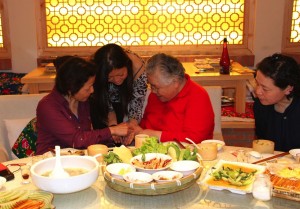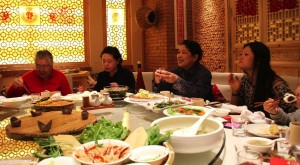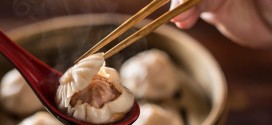As a nod to this month’s theme of food, mother and daughter blogging team Jian and Lisa are tackling cultural traditions around eating and drinking.

Jian: Do you remember as a teenager, you’d never want to have Chinese food when we went out to eat? Whenever I asked you what kind of cuisine you’d like, you always gave me the answer “Anything but Chinese.”
Lisa: Probably part of an overarching rejection of heritage and culture. Let’s leave it to that. I like it now, right?
Jian: I’m glad you do. It used to drive me nuts! You know, eating and preparing meals is such a huge part of Chinese culture. I still remember growing up in northern China making dumplings at home. It is not only the joy of eating them, but also the family working together to make them. It’s a family bonding time.
Lisa: The dumpling tradition to me is nice, but it’s a lot of work for a simple meal. I mean, making dough, cutting the veggies, rolling the wrap, and making the dumplings. It’s so labor intensive. Well, we’re all small families now, aren’t we, what with the one-child policy and globalization scattering us to the four winds.

Jian: That’s what makes family dining more important. Especially extended family. I miss such large family gatherings. The constant cheers with clicking glasses and acknowledgement “speeches” by family members. We don’t say “thank you” to each other within the family—that would sound pretentious and distanced. But over a meal, one can express his/her appreciation for what the other members have done. I’m getting rusty for lack of practice, but always appreciate my sisters’ talks—eloquence and sincerity. They notice and remember everything.
Lisa: That always gives me so much anxiety at family functions, or when we have dinners with people from the Chinese Consulate here. Well, giving a small toast in English is okay, but trying to sound eloquent in Chinese, that is hard. And needing to wait for a collective sip? All that clinking and formality for just one dinner…
Jian: The Chinese put a lot of emphasis on food sharing and rituals. You toast and cheer when you have a sip of your drink. Never drink on your own. And you click your glass at a lower position to the glasses of those who are your seniors in age or position. You always prepare extra food. “Yu,” extra, symbolizes abundance. So on and on.
Lisa: But what I hate about the eating traditions in China is all the over-ordering. I remember being taught that at a banquet for example, it is a sign of a bad hostess when everything ordered is consumed. To demonstrate your graciousness and generosity, you should always order more than would ever be eaten. Of course, working in sustainability, that drives me insane—all that food waste and its implications on production stress, its post-consumer environmental impact, not to mention the social implications.
Jian: The waste in China today appalls me, too, especially at the lavish business banquets. But I wouldn’t say such behavior is tradition. I hope the austerity and anti-corruption campaign undertaking by the Chinese Government now will curb such waste. However, I believe that over ordering does have something to do with the culture of showing hospitality. There is always plenty of food at family dining, particularly when there are guests. But no matter eating out or dining at home, the leftovers are saved and consumed later on, not wasted. A Chinese host would be mortified if all the dishes on the table are gone—it would be an indication of not providing enough. An equivalent of being stingy, perhaps worse, not being hospitable.
Read more of Jian and Lisa’s blog posts here.
Asian Fortune is an English language newspaper for Asian American professionals in the Washington, DC metropolitan area. Visit fb.com/asianfortune to stay up to date with our news and what’s going on in the Asian American community.
 Asian Fortune Your source for all things Asian American
Asian Fortune Your source for all things Asian American



